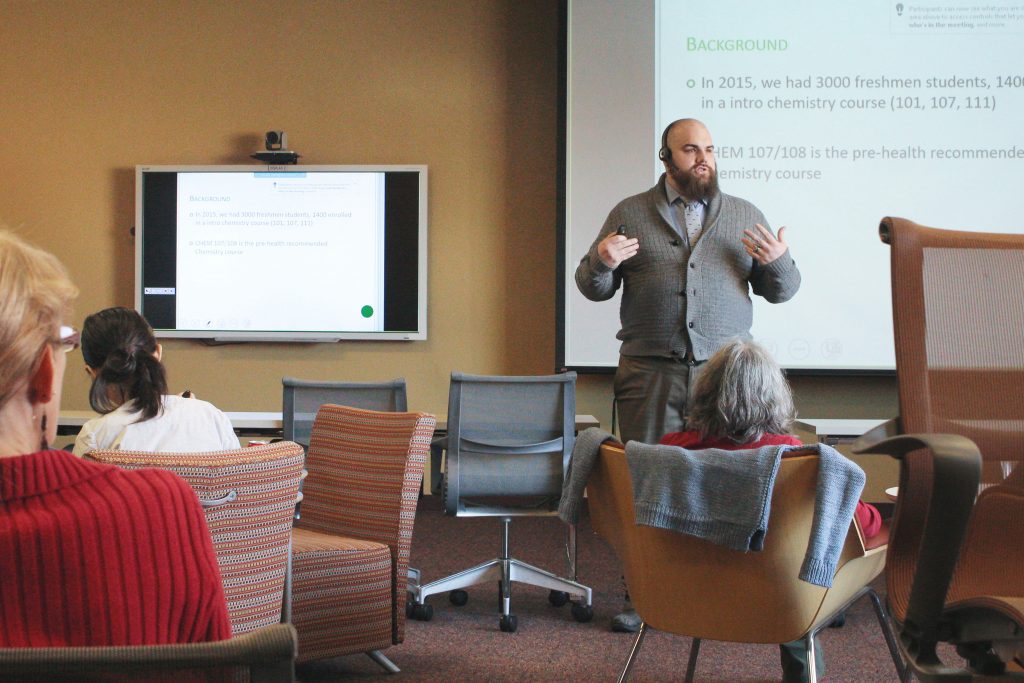
Benjamin Turnpenny, a lecturer in the chemistry department at Binghamton University, is no stranger to the problems posed by large lecture courses. On Friday, he spoke to a group of faculty in the Center for Learning and Teaching (CLT) on ways to integrate office hours to ensure student success.
Integrated office hours are a new method of combining in person office hours with online resources and tutoring to ensure students constantly have access to help — particularly in large lecture courses where resources are often stretched thin. Turnpenny teaches Chemistry 107: Introductory Chemistry I, an introductory course that has over 900 students and is expected to increase in size following the opening of BU’s School of Pharmacy and Pharmaceutical Sciences.
Turnpenny surveyed his students and found that most wanted to see more office hours, even though many were not attending the ones already available due to not having time, being intimidated by professors or not knowing which questions to ask.
“We know that students consider our introductory chemistry courses some of the toughest here at the University,” he said.
With this information in mind, Turnpenny began to work on integrating office hours with online resources. He began to live stream tutoring sessions once per week using the CLT’s new learning studio, which features touch-screen smart televisions and video recording as well as editing equipment. After live streaming the sessions, he posts them to Blackboard so that students could re-watch them. Normally, Turnpenny reviews five to seven practice problems per live stream and allows students who attend the tutoring session in person to ask questions as he reviews, while allowing students at home to communicate via chat.
According to Andrea MacArgel, an instructional designer at the CLT, the event was designed to give faculty on campus new ways to reach students and ensure student success.
“We are hoping that other large gateway courses can do something similar to this,” MacArgel said. “The chemistry courses are some of the most successful courses in the University, and we would like to help other courses become more effective at reaching a large audience.”
Since implementing the idea in fall 2015, the percentage of students failing or almost failing Chemistry 107: Introduction Chemistry I and Chemistry 108: Introductory Chemistry II has dropped from around 15 percent to below 10 percent. In addition, data from the live streams indicate that between 60 and 70 percent of Turnpenny’s introductory chemistry students watch the videos.
“This is showing the integrated office hours are giving students an opportunity to participate, learn and get help when they need it,” Turnpenny said. “It breaks that professor-to-student relationship and helps students feel more comfortable in their learning environment. The courses are still difficult, but students have more help.”
Sara Reiter, a professor of accounting, stated that she thought the integrated office hours could be applied to classes of all sizes.
“Most students cannot come to regular office hours because they have classes during the day, so non-traditional office hours could be beneficial,” Reiter said.
In addition to live streaming tutoring videos, Turnpenny discussed how to build a library of videos from former sessions and how to reach out to students using surveys. He has plans for improving his own integrated office hours that include allowing students to suggest topics for the sessions and posting the questions covered beforehand so students can try them for themselves. Although the system occasionally experiences technical hiccups, Turnpenny is convinced that it is working for his students.
“It isn’t a flawless system, but students are becoming more comfortable using these resources and participation is outstanding,” Turnpenny said. “It is working and they are improving their grades.”


